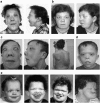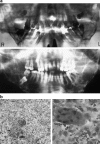Multiple giant cell lesions in patients with Noonan syndrome and cardio-facio-cutaneous syndrome
- PMID: 18854871
- PMCID: PMC2986220
- DOI: 10.1038/ejhg.2008.188
Multiple giant cell lesions in patients with Noonan syndrome and cardio-facio-cutaneous syndrome
Abstract
Noonan syndrome (NS) and cardio-facio-cutaneous syndrome (CFCS) are related developmental disorders caused by mutations in genes encoding various components of the RAS-MAPK signaling cascade. NS is associated with mutations in the genes PTPN11, SOS1, RAF1, or KRAS, whereas CFCS can be caused by mutations in BRAF, MEK1, MEK2, or KRAS. The NS phenotype is rarely accompanied by multiple giant cell lesions (MGCL) of the jaw (Noonan-like/MGCL syndrome (NL/MGCLS)). PTPN11 mutations are the only genetic abnormalities reported so far in some patients with NL/MGCLS and in one individual with LEOPARD syndrome and MGCL. In a cohort of 75 NS patients previously tested negative for mutations in PTPN11 and KRAS, we detected SOS1 mutations in 11 individuals, four of whom had MGCL. To explore further the relevance of aberrant RAS-MAPK signaling in syndromic MGCL, we analyzed the established genes causing CFCS in three subjects with MGCL associated with a phenotype fitting CFCS. Mutations in BRAF or MEK1 were identified in these patients. All mutations detected in these seven patients with syndromic MGCL had previously been described in NS or CFCS without apparent MGCL. This study demonstrates that MGCL may occur in NS and CFCS with various underlying genetic alterations and no obvious genotype-phenotype correlation. This suggests that dysregulation of the RAS-MAPK pathway represents the common and basic molecular event predisposing to giant cell lesion formation in patients with NS and CFCS rather than specific mutation effects.
Figures


Similar articles
-
Cardio-facio-cutaneous and Noonan syndromes due to mutations in the RAS/MAPK signalling pathway: genotype-phenotype relationships and overlap with Costello syndrome.J Med Genet. 2007 Dec;44(12):763-71. doi: 10.1136/jmg.2007.050450. Epub 2007 Aug 17. J Med Genet. 2007. PMID: 17704260 Free PMC article.
-
SOS1 is the second most common Noonan gene but plays no major role in cardio-facio-cutaneous syndrome.J Med Genet. 2007 Oct;44(10):651-6. doi: 10.1136/jmg.2007.051276. Epub 2007 Jun 23. J Med Genet. 2007. PMID: 17586837 Free PMC article.
-
Germline BRAF mutations in Noonan, LEOPARD, and cardiofaciocutaneous syndromes: molecular diversity and associated phenotypic spectrum.Hum Mutat. 2009 Apr;30(4):695-702. doi: 10.1002/humu.20955. Hum Mutat. 2009. PMID: 19206169 Free PMC article.
-
Case report: Noonan syndrome with multiple giant cell lesions and review of the literature.Am J Med Genet A. 2012 Sep;158A(9):2283-9. doi: 10.1002/ajmg.a.35493. Epub 2012 Jul 27. Am J Med Genet A. 2012. PMID: 22848035 Review.
-
Noonan, Costello and cardio-facio-cutaneous syndromes: dysregulation of the Ras-MAPK pathway.Expert Rev Mol Med. 2008 Dec 9;10:e37. doi: 10.1017/S1462399408000902. Expert Rev Mol Med. 2008. PMID: 19063751 Review.
Cited by
-
Atrioventricular canal defect in patients with RASopathies.Eur J Hum Genet. 2013 Feb;21(2):200-4. doi: 10.1038/ejhg.2012.145. Epub 2012 Jul 11. Eur J Hum Genet. 2013. PMID: 22781091 Free PMC article.
-
Insight into the pathogenesis and nature of Central Giant Cell Lesions of the Jaws.Med Oral Patol Oral Cir Bucal. 2015 Mar 1;20(2):e196-8. doi: 10.4317/medoral.20499. Med Oral Patol Oral Cir Bucal. 2015. PMID: 25681371 Free PMC article. Review.
-
Imatinib, a New Adjuvant Medical Treatment for Multifocal Villonodular Synovitis Associated to Noonan Syndrome: A Case Report and Literature Review.Front Med (Lausanne). 2022 Jan 17;8:817873. doi: 10.3389/fmed.2021.817873. eCollection 2021. Front Med (Lausanne). 2022. PMID: 35111788 Free PMC article.
-
Case Report: Safety and Efficacy of Denosumab in Four Children With Noonan Syndrome With Multiple Giant Cell Lesions of the Jaw.Front Pediatr. 2020 Sep 18;8:515. doi: 10.3389/fped.2020.00515. eCollection 2020. Front Pediatr. 2020. PMID: 33042901 Free PMC article.
-
Craniofacial and cutaneous findings in Noonan, Costello and LEOPARD syndromes.Postepy Dermatol Alergol. 2018 Oct;35(5):437-441. doi: 10.5114/pdia.2017.70330. Epub 2018 Jul 19. Postepy Dermatol Alergol. 2018. PMID: 30429698 Free PMC article. Review.
References
-
- Noonan JA. Hypertelorism with Turner phenotype. A new syndrome with associated congenital heart disease. Am J Dis Child. 1968;116:373–380. - PubMed
-
- Tartaglia M, Mehler EL, Goldberg R, et al. Mutations in PTPN11, encoding the protein tyrosine phosphatase SHP-2, cause Noonan syndrome. Nat Genet. 2001;29:465–468. - PubMed
-
- Roberts AE, Araki T, Swanson KD, et al. Germline gain-of-function mutations in SOS1 cause Noonan syndrome. Nat Genet. 2007;39:70–74. - PubMed
-
- Tartaglia M, Pennacchio LA, Zhao C, et al. Gain-of-function SOS1 mutations cause a distinctive form of Noonan syndrome. Nat Genet. 2007;39:75–79. - PubMed
Publication types
MeSH terms
Substances
Grants and funding
LinkOut - more resources
Full Text Sources
Research Materials
Miscellaneous

